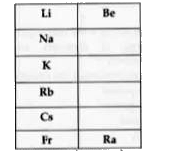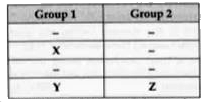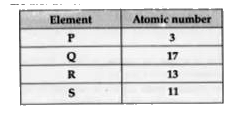Complete Solutions to TOPIC:2-SHORT ANSWER TYPE QUESTIONS-I of chapter PERIODIC CLASSIFICATION OF ELEMENTS of Class 10 book with complete answers and questions
| Class 10 | CHEMISTRY |
| Chapter | PERIODIC CLASSIFICATION OF ELEMENTS |
| OSWAAL PUBLICATION | TOPIC:2-SHORT ANSWER TYPE QUESTIONS-I |
| Number Of Questions | 25 |
| Academic Year | 2023-24 |
What is ionisation energy? How does ionisation energy vary along the period in the modern periodic table ?
02:39View SolutionWhat are electropositive atoms? How does electropositivity vary along the period in modern periodic table ?
01:49View SolutionElements in the periodic table show periodicity of properties. List any four such properties.
02:53View SolutionMention any two trends exhibited by elements when we go from left to right across the period of periodic table.
01:43View SolutionHow does the metallic character of the elements vary (i) in a group, (ii) in a period of the modern periodic table ?
02:12View SolutionHow would the tendency to lose electrons change as you go
i] from left to right across a period
ii] down a group04:04View SolutionHow does the atomic radius change as we go :
(i) from left to right across a period
(ii) down a group in the periodic table ?01:59View Solution(i) State the basis of classification of elements in the modern periodic table ?
(ii) How does the metallic character of element vary as we go down the group.04:18View SolutionHow does metallic character of elements vary on moving from :
(i) Left to right in a period ?
(ii) From top to bottom in a group ?
Give reasons for your answers.04:50View SolutionThe atomic radii of three elements A, B and C of a periodic table are 186 pm, 104 pm and 143 pm respectively. Giving a reason, arrange these elements in the increasing order of atomic numbers in the period.
03:24View Solution(i) Atomic number of Mg and Al are 12 and 13, respectively. Write down their electronic configuration.
(ii) Mention the period of the modern periodic table to which the above two elements belong. Give reason for your answer.02:29View SolutionArrange the following elements in the descending order of atomic size and give a reason for your answer. Mg, CI, P. Ar Atomic number of elements is 12, 17, 15, 18.
05:44View SolutionThree elements X, Y and Z belong to `17^(th)` group but `2^(nd),3^(rd)and4^(th)` period respectively. Number of valence electrons in Y is 7. Find the number of valence electrons in X and Z.
02:57View Solutioni] Atomic radius of hydrogen is 37 pm. Express it in metres.
ii] How does atomic size vary in a group and in a period.03:48View SolutionNitrogen (atomic number 7) and phosphorous (atomic number 15) belong to group 15 of the periodic table. Write the electron configurations of these two elements. Which of these is more electronegative?
05:36View SolutionNa, Mg, Al and P belong to `3^(rd)` period but are placed in first, second, thirteenth and fifteenth group. Number of shells occupied in Mg is three. What is the number of occupied shells in Na, Al and P. Give reasons for your answer.
04:17View Solution(i) Element 'Y' with atomic number 3 combines with element 'A' with atomic number 17. What would be the formula of the compound ?
(ii) What is the electronic configuration of an element with atomic number 10 ? What will be its valency?03:07View Solution(i) How does the tendency to gain electrons change as we go down the group ? Give reason.
(ii) Given below is a part of the periodic table. How does the valency vary, as we move vertically downward from Li to Fr. Give reason.
 04:22View Solution
04:22View SolutionGiven below are atomic radii of same elements of second period.
`{:("Element","B","O","N","C"),("Atomic Radii in pm","88","66","74","77"):}`
Arrange these elements in the increasing order of their atomic number. Give reason for your answer.03:11View SolutionOut of the elements X and Y, which has bigger atomic radius? Give reason to justify your answer.
(i) X has atomic number 18 and atomic mass 40.
(ii) Y has atomic number 20 and atomic mass 40.02:59View SolutionTwo elements X and Y have atomic numbers 12 and 16 respectively. To which period of the modern periodic table do these two elements belong ? What type of bond will be formed between them and why?
02:36View SolutionThe atomic number of elements A, B, C, D and E are given below:

From the above table, answer the following questions :
(i) Which two elements are chemically similar ?
(ii) Which is an inert gas ?
(iii) Which element belongs to 3 period of periodic table ?
(iv) Which element among these is a non-metal ?02:45View SolutionThe position of three elements X, Y and Z in the periodic table are shown below:
(i) Which type of ion, cation or anion, will be formed by element X ?
(ii) Which element, Y or z, has the atom of comparatively larger size ?
Give reason in each case.
 03:12View Solution
03:12View Solution(i) An element has electronic configuration 2, 8, 6. Explain its position in the periodic table.
(ii) Size of sodium atom is bigger than that of hydrogen atom. Why?04:06View SolutionSome of the elements and their atomic numbers are mentioned in the following table :

(i) How many valence electrons are there in the element 'R' ?
(ii) What is the valency of 'P' ?
(ii) Write the chemical formula of the compound formed by combining the elements ‘P' and 'Q'?
(iv) Out of the two elements 'P' and 'S', which one is larger in size ?03:54View Solution
TOPIC:2-SHORT ANSWER TYPE QUESTIONS-I questions and complete solutions for chapter PERIODIC CLASSIFICATION OF ELEMENTS of OSWAAL CHEMISTRY (KANNADA ENGLISH) of Class 10
All Exercises from OSWAAL PUBLICATION Class 10 CHEMISTRY PERIODIC CLASSIFICATION OF ELEMENTS
- NCERT CORNER - TEXTBOOK EXERCISES
- NCERT CORNER -INTEXT QUESTIONS
- TOPIC:1- LONG ANSWER TYPE QUESTIONS
- TOPIC:1- MATCH THE COLUMN
- TOPIC:1- MULTIPLE CHOICE QUESTIONS
- TOPIC:1- SHORT ANSWER TYPE QUESTIONS-I
- TOPIC:1- SHORT ANSWER TYPE QUESTIONS-II
- TOPIC:1- VERY SHORT ANSWER TYPE QUESTIONS
- TOPIC:1-MULTIPLE CHOICE QUESTIONS
- TOPIC:2- LONG ANSWER TYPE QUESTIONS
- TOPIC:2- SHORT ANSWER TYPE QUESTIONS-II
- TOPIC:2- VERY SHORT ANSWER TYPE QUESTIONS
- TOPIC:2-MULTIPLE CHOICE QUESTION
- TOPIC:2-SHORT ANSWER TYPE QUESTIONS-I
